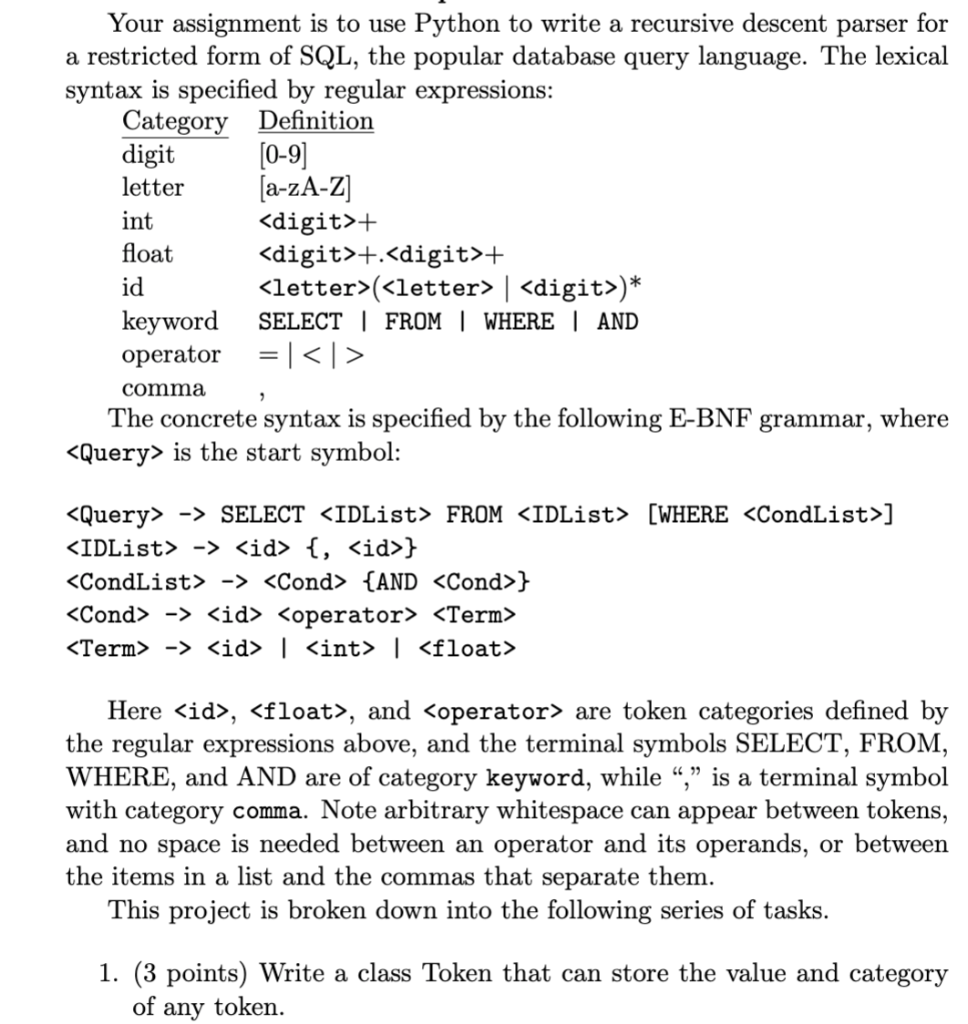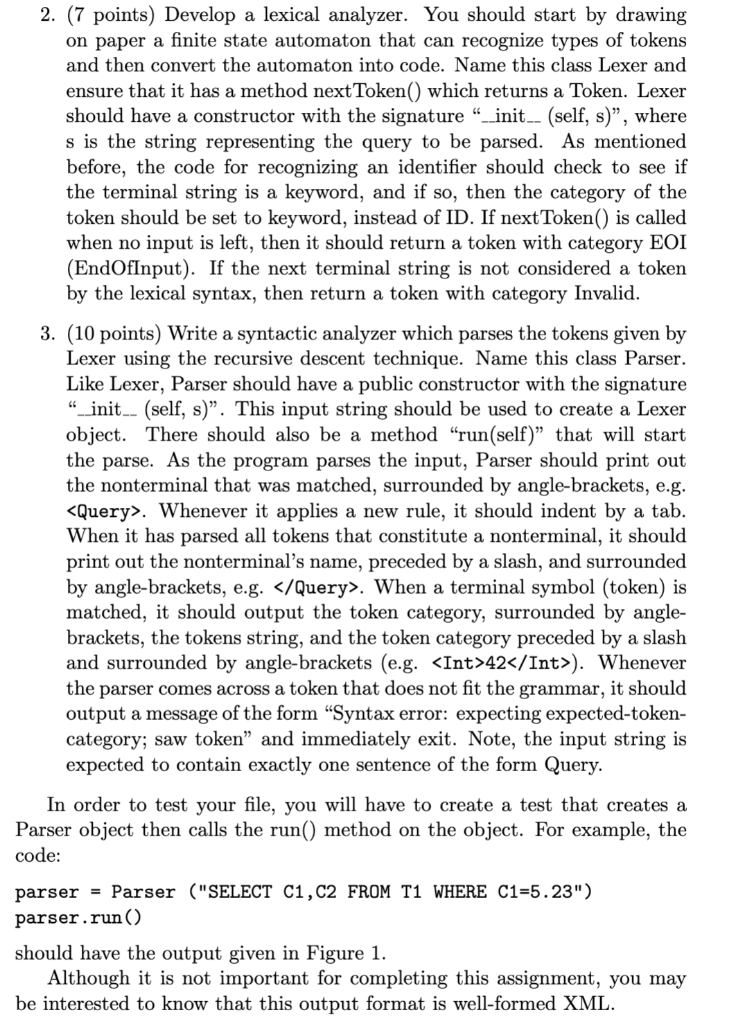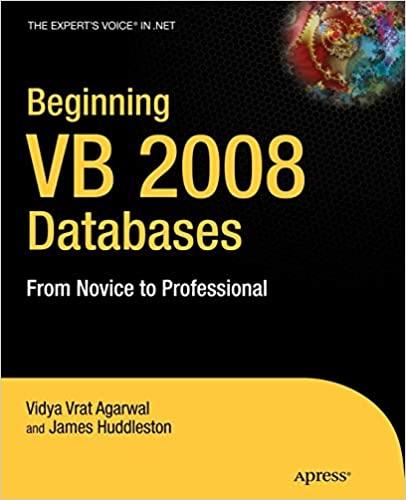This code should be in Python.


int Your assignment is to use Python to write a recursive descent parser for a restricted form of SQL, the popular database query language. The lexical syntax is specified by regular expressions: Category Definition digit [0-9] letter [a-zA-Z]
+ float +.+ id ( | )* keyword SELECT | FROM WHERE AND operator = [ comma The concrete syntax is specified by the following E-BNF grammar, where is the start symbol: -> SELECT FROM [WHERE ] -> {, {id>} -> {AND } -> -> | | Here , , and are token categories defined by the regular expressions above, and the terminal symbols SELECT, FROM, WHERE, and AND are of category keyword, while ," is a terminal symbol with category comma. Note arbitrary whitespace can appear between tokens, and no space is needed between an operator and its operands, or between the items in a list and the commas that separate them. This project is broken down into the following series of tasks. 1. (3 points) Write a class Token that can store the value and category of any token. 2. (7 points) Develop a lexical analyzer. You should start by drawing on paper a finite state automaton that can recognize types of tokens and then convert the automaton into code. Name this class Lexer and ensure that it has a method nextToken() which returns a Token. Lexer should have a constructor with the signature " init__(self, s)", where s is the string representing the query to be parsed. As mentioned before, the code for recognizing an identifier should check to see if the terminal string is a keyword, and if so, then the category of the token should be set to keyword, instead of ID. If nextToken() is called when no input is left, then it should return a token with category EOI (EndOfInput). If the next terminal string is not considered a token by the lexical syntax, then return a token with category Invalid. 3. (10 points) Write a syntactic analyzer which parses the tokens given by Lexer using the recursive descent technique. Name this class Parser. Like Lexer, Parser should have a public constructor with the signature init_- (self, s). This input string should be used to create a Lexer object. There should also be a method "run(self) that will start the parse. As the program parses the input, Parser should print out the nonterminal that was matched, surrounded by angle-brackets, e.g. . Whenever it applies a new rule, it should indent by a tab. When it has parsed all tokens that constitute a nonterminal, it should print out the nonterminal's name, preceded by a slash, and surrounded by angle-brackets, e.g. . When a terminal symbol (token) is matched, it should output the token category, surrounded by angle- brackets, the tokens string, and the token category preceded by a slash and surrounded by angle-brackets (e.g. 42). Whenever the parser comes across a token that does not fit the grammar, it should output a message of the form "Syntax error: expecting expected-token- category; saw token" and immediately exit. Note, the input string is expected to contain exactly one sentence of the form Query. In order to test your file, you will have to create a test that creates a Parser object then calls the run() method on the object. For example, the code: parser = Parser ("SELECT C1,C2 FROM T1 WHERE C1=5.23") parser.run() should have the output given in Figure 1. Although it is not important for completing this assignment, you may be interested to know that this output format is well-formed XML. int Your assignment is to use Python to write a recursive descent parser for a restricted form of SQL, the popular database query language. The lexical syntax is specified by regular expressions: Category Definition digit [0-9] letter [a-zA-Z] + float +.+ id ( | )* keyword SELECT | FROM WHERE AND operator = [ comma The concrete syntax is specified by the following E-BNF grammar, where is the start symbol: -> SELECT FROM [WHERE ] -> {, {id>} -> {AND } -> -> | | Here , , and are token categories defined by the regular expressions above, and the terminal symbols SELECT, FROM, WHERE, and AND are of category keyword, while ," is a terminal symbol with category comma. Note arbitrary whitespace can appear between tokens, and no space is needed between an operator and its operands, or between the items in a list and the commas that separate them. This project is broken down into the following series of tasks. 1. (3 points) Write a class Token that can store the value and category of any token. 2. (7 points) Develop a lexical analyzer. You should start by drawing on paper a finite state automaton that can recognize types of tokens and then convert the automaton into code. Name this class Lexer and ensure that it has a method nextToken() which returns a Token. Lexer should have a constructor with the signature " init__(self, s)", where s is the string representing the query to be parsed. As mentioned before, the code for recognizing an identifier should check to see if the terminal string is a keyword, and if so, then the category of the token should be set to keyword, instead of ID. If nextToken() is called when no input is left, then it should return a token with category EOI (EndOfInput). If the next terminal string is not considered a token by the lexical syntax, then return a token with category Invalid. 3. (10 points) Write a syntactic analyzer which parses the tokens given by Lexer using the recursive descent technique. Name this class Parser. Like Lexer, Parser should have a public constructor with the signature init_- (self, s). This input string should be used to create a Lexer object. There should also be a method "run(self) that will start the parse. As the program parses the input, Parser should print out the nonterminal that was matched, surrounded by angle-brackets, e.g. . Whenever it applies a new rule, it should indent by a tab. When it has parsed all tokens that constitute a nonterminal, it should print out the nonterminal's name, preceded by a slash, and surrounded by angle-brackets, e.g. . When a terminal symbol (token) is matched, it should output the token category, surrounded by angle- brackets, the tokens string, and the token category preceded by a slash and surrounded by angle-brackets (e.g. 42). Whenever the parser comes across a token that does not fit the grammar, it should output a message of the form "Syntax error: expecting expected-token- category; saw token" and immediately exit. Note, the input string is expected to contain exactly one sentence of the form Query. In order to test your file, you will have to create a test that creates a Parser object then calls the run() method on the object. For example, the code: parser = Parser ("SELECT C1,C2 FROM T1 WHERE C1=5.23") parser.run() should have the output given in Figure 1. Although it is not important for completing this assignment, you may be interested to know that this output format is well-formed XML








